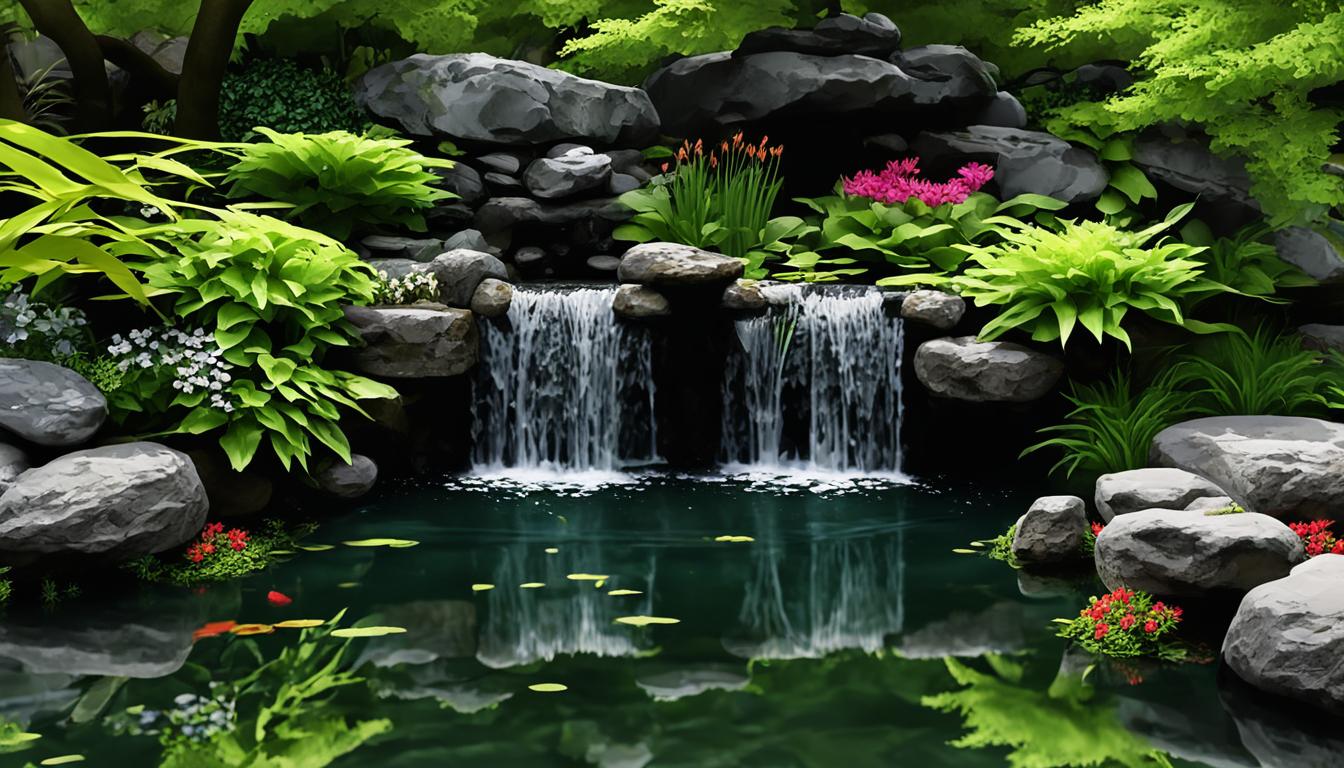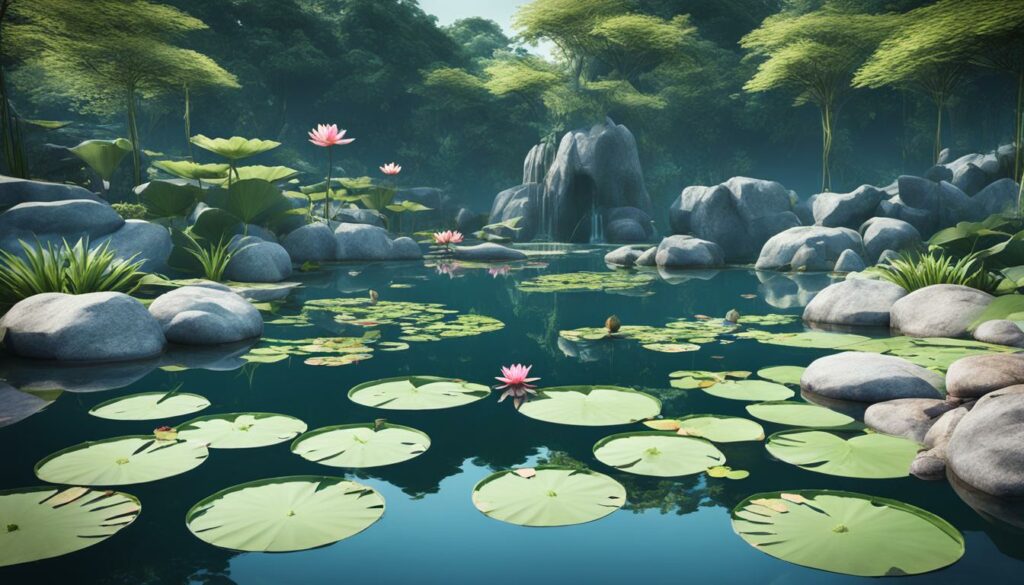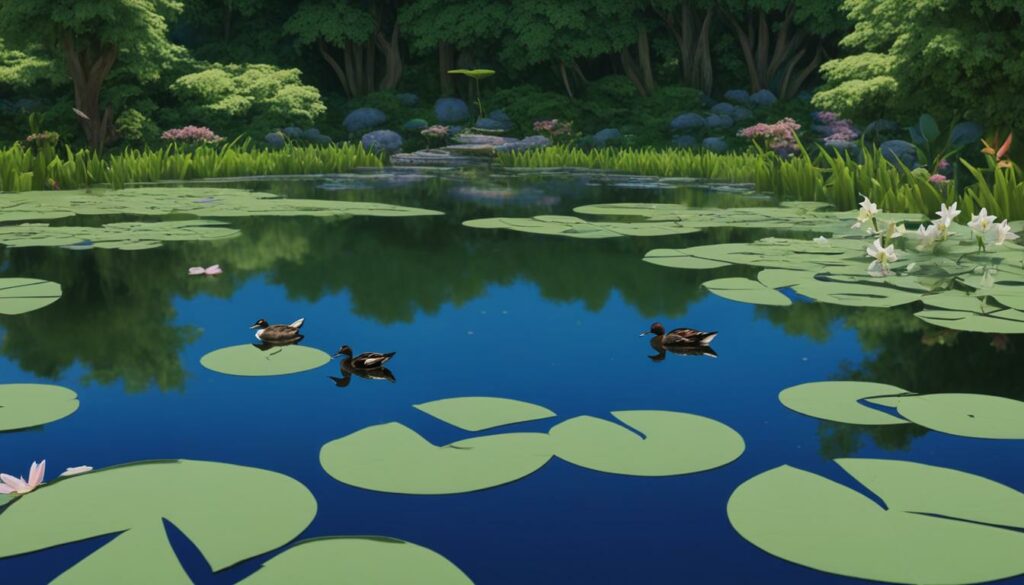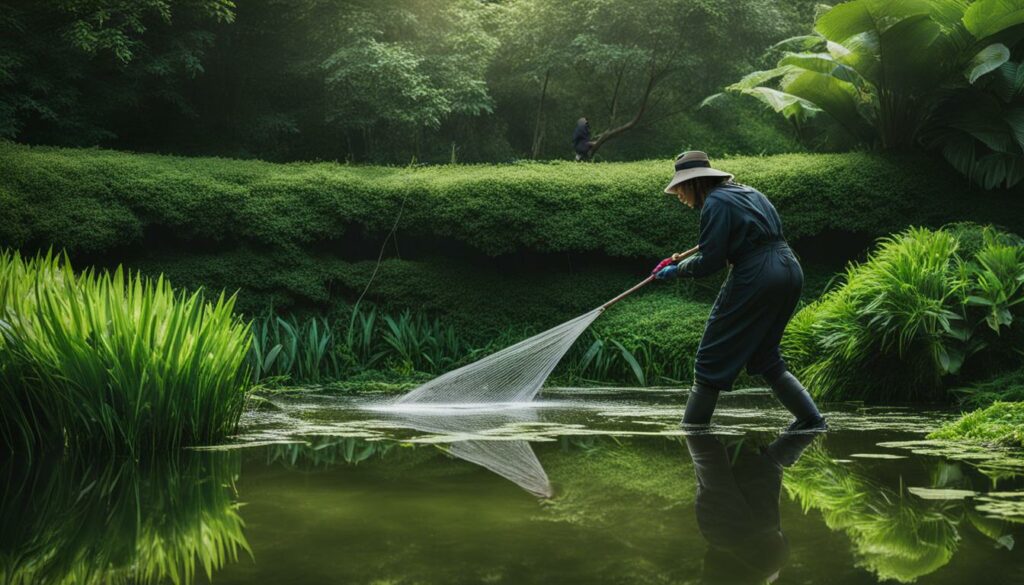
Enhancing outdoor living spaces through the integration of garden ponds and water features not only elevates the visual charm of landscape design but also promotes a sense of tranquility and natural balance. Delving into the realm of pond design, we uncover how these aquatic elements can transform gardens into picturesque sanctuaries. A carefully crafted pond becomes a symphony of movement and reflection, harmonizing with the chorus of nature and drawing the admiration of those who seek both aesthetic beauty and ecological enrichment within their landscapes.
Key Takeaways
- Effective pond design can substantially enhance landscape aesthetics and ecosystem balance.
- Garden ponds serve as a vibrant collection point for both visual interest and wildlife interaction.
- Water features are not mere ornaments but play a pivotal role in creating a soothing outdoor ambiance.
- The thoughtful arrangement of aquatic elements invites a deeper connection with the natural world.
- Implementing a pond into landscape design can offer both personal enjoyment and habitat support for various species.
Conceptualizing Your Pond Layout
When envisioning the addition of a serene water element to your outdoor sanctuary, considering the unique attributes of your landscape is essential. The foundation of a breathtaking garden pond lies in the thoughtful integration of pond installation into the natural contours and characteristics of your existing outdoor space. As you embark on this transformative journey, remember that each choice—from the aquatic plants to the vibrant koi ponds—plays a critical role in crafting not only a visual masterpiece but an ecological haven as well.
Assessing Your Landscape for Pond Design
Begin by surveying the lay of the land—its topography, natural water flow, and areas graced by sunlight or shade. These elements will guide your decisions and ensure that your garden ponds thrive. Consider how each section of your landscape could complement the reflective beauty of a water feature, keeping in mind both underground utilities and the types of flora and fauna that will populate the space.
Integrating Pond Design with Existing Garden Elements
A harmonious balance between your new pond and existing garden features is vital. Reflect on the colors and textures of your current vegetation and structures. Imagine the flow from patios to pathways, flower beds to water's edge—a continuity that seamlessly blends man-made artistry with natural splendor. Especially for koi ponds, it's imperative to provide an environment that supports the health and showcase of these living jewels.
Creating a Focal Point with Your Pond
To elevate the visual impact of your pond, position it as the heart of your garden—the eye is naturally drawn to water, making it an ideal focal point. Strategize on the placement to capture the interplay of light and movement, crafting reflections that mesmerize and soothe. Whether encircled by lush aquatic plants or standing as a solitary element of contemplation, ensure your pond leaves an indelible impression on all who encounter it.

With a clear vision and a detailed plan, your garden ponds will transform into enchanting ecosystems that draw in admirers and wildlife alike, creating a tranquil retreat that resonates with the natural world's symphony.
Choosing the Right Equipment and Materials
Embarking on pond installation or incorporating water features into your landscape design demands careful selection of equipment and materials to ensure longevity and compatibility with the surrounding environment. Durability and aesthetic blend are of paramount importance.
The foundation of a high-quality pond is selecting the proper liner. A liner acts as a barrier to prevent water from seeping into the soil, which makes choosing one that is both puncture-resistant and flexible crucial for your landscape. Material options include reinforced polyethylene and EPDM rubber, both known for their robustness and ability to conform to various shapes and depths.
When considering pumps and filters, it's essential to account for the size and type of pond you envision. A well-sized pump ensures water circulation and aeration while the right filter keeps the water clean and clear, contributing to the overall health of the pond ecosystem.
In addition to these core components, the selection of stones, aquatic plants, and lighting should not only fulfill functional requirements—such as providing a habitat for pond life—but also enhance the beauty and cohesiveness of the design. Using natural stone can integrate the water feature more seamlessly into the landscape.
- Pond Liners: Choose based on durability, flexibility, and size requirements.
- Pumps: Calculate the correct pump size for water circulation needs.
- Filters: Opt for a filter that can handle the biological load and maintain clarity.
- Aquatic Plants: Select plants that complement your design while contributing to the pond's ecological balance.
- Lighting: Consider energy-efficient LED lights to enhance the feature's visibility and ambiance at night.
The careful assembly of these materials will not only ensure the immediate appeal of the water feature but also its sustainability over time, diminishing the need for frequent renovations and repairs.
With attention to these details, your water feature will emerge as a natural and integral part of your landscape, giving life and movement to your outdoor space.
Incorporating Aquatic Plants and Wildlife
The integration of aquatic plants and wildlife is not only essential for the visual appeal of water gardens but also for strengthening pond health. A well-balanced aquatic ecosystem supports a diversity of life while maintaining clarity and quality of the water. In this section, we will look into the strategic selection of plants, inviting a vibrant array of wildlife to your pond, and the overall significance these elements bring to the health and beauty of your water garden.
Selecting Aquatic Plants for Aesthetic and Ecological Balance
Choosing the right variety of aquatic plants can create a visually stunning water garden and ensures ecological balance. Plants like water lilies, cattails, and lotus not only provide shelter and oxygen for aquatic creatures but also contribute to the pond's filtration system, which is vital for preventing excessive algae growth. Consider plants that thrive in your regional climate and can provide year-round foliage and blooming cycles for continuous allure.
Attracting Wildlife to Your Pond Ecosystem

Creating a habitat that attracts wildlife transforms your pond into a living masterpiece. From amphibians such as frogs and toads to beneficial insects and visiting birds, your water feature can become a sanctuary for local wildlife. To entice them, ensure your pond has shallow areas, a variety of plant life, and avoid using chemicals that can harm these potential visitors.
Understanding the Role of Aquatic Plants in Pond Health
Aquatic plants are not just decoration; they are fundamental for maintaining a healthy pond ecosystem. Their roots absorb nutrients from the water that might otherwise fuel unwelcome algae, and their presence increases the water's oxygen level, which is vital for all aquatic life. A strategic selection of floating, submerged, and marginal plants can ensure a balanced and thriving pond.
- Floating plants such as duckweed and water lettuce provide shade and reduce sunlight penetration, deterring algal blooms.
- Submerged plants like hornwort and eelgrass play a crucial role in oxygenating the water.
- Margin plants, including irises and rushes, offer essential breeding and nesting grounds for a variety of pond wildlife.
By thoughtfully incorporating a diverse mix of aquatic plants and encouraging wildlife habitation, you create a self-sustaining ecosystem that not only exudes natural beauty but also promotes the long-term health and vitality of your pond.
Pond Maintenance and Care
Maintaining a pristine pond requires dedication and a comprehensive understanding of various caretaking methods. As the seasons shift, it becomes crucial to adapt your approach to ensure the serene water feature remains a cornerstone of your landscape's allure. Within this framework, regular cleaning, careful water quality management, and a steadfast awareness of the challenges of each season are the keys to an enchanting and healthy pond.

Regular Cleaning and Water Quality Management
Effective pond maintenance is anchored in habitual cleaning and monitoring of water parameters. Debris removal, such as fallen leaves and excess plant material, should be an ongoing activity to prevent organic matter from decomposing in the water, which can lead to nutrient imbalances and poor water quality. Additionally, it is vital to regularly check and maintain the right pH levels, as well as monitor for nitrogen compounds that can be harmful to fish and other aquatic life.
Seasonal Pond Care Tips
- Spring: Inspect the pond for any damage from winter, clean out any detritus that has accumulated, and gradually reintroduce aquatic life as temperatures rise.
- Summer: Ensure adequate aeration and water circulation to maintain oxygen levels, and monitor the pond more frequently due to increased metabolic rates in warmer weather.
- Fall: Prepare your pond for the colder months by trimming back plants, installing netting to catch leaves, and considering the use of a pond heater or de-icer.
- Winter: Keep part of the pond surface ice-free to enable gas exchange and protect your pond's inhabitants from being trapped beneath the ice.
Addressing Common Pond Problems and Solutions
- To combat algae overgrowth, consider adding more aquatic plants that compete with algae for nutrients, employ UV clarifiers, and ensure regular cleaning.
- In case of pond leaks, identify the source of the leakage and utilize quality pond repair kits or professional services for restoration.
- For fish health issues, maintain good water quality, avoid overfeeding, and create a balanced ecosystem with a variety of plant and animal life.
In essence, pond maintenance and water quality management are critical to the longevity and beauty of your pond. With the right strategies in place, your commitment will be reflected in the clear, thriving waters of your personal outdoor sanctuary, regardless of the season.
Conclusion
In the realm of landscape aesthetics, the addition of a garden pond is more than just an enhancement; it's a transformative element that infuses tranquility and beauty into outdoor spaces. Throughout this article, we've steered through the intricacies of pond design, from conceptualizing layouts to the selection of harmonious aquatic flora and fauna. Embracing the principles outlined can lead to the creation of stunning water features that not only elevate the visual appeal of gardens but also serve as thriving havens for indigenous wildlife.
The significance of such water features extends beyond mere decoration; they embody the essence of ecological stewardship. By crafting these mini-ecosystems, you invite a symphony of life, contributing positively to local biodiversity. It's a thoughtful nod to environmental sustainability that, with proper planning and installation, ensures these ponds support life and endure through the seasons.
As we close the chapter on this guide, remember that garden ponds can be the pulsing heart of your outdoor domain, with ripples of impact that extend into the environment. By marrying aesthetics with ecology, and with diligent maintenance, your pond will not only stand as a testament to good design but will proliferate life, tranquility, and the pure enjoyment of nature's gifts.








